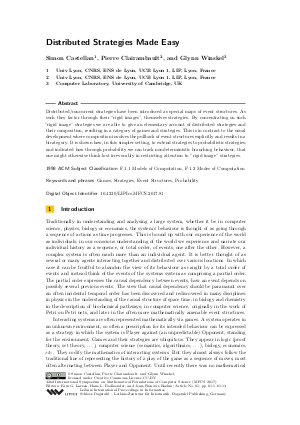Distributed Strategies Made Easy
Authors Simon Castellan, Pierre Clairambault, Glynn Winskel
-
Part of:
Volume:
42nd International Symposium on Mathematical Foundations of Computer Science (MFCS 2017)
Part of: Series: Leibniz International Proceedings in Informatics (LIPIcs)
Part of: Conference: Mathematical Foundations of Computer Science (MFCS) - License:
 Creative Commons Attribution 3.0 Unported license
Creative Commons Attribution 3.0 Unported license
- Publication Date: 2017-12-01
File

PDF
LIPIcs.MFCS.2017.81.pdf
- Filesize: 488 kB
- 13 pages
Document Identifiers
Subject Classification
Keywords
- Games
- Strategies
- Event Structures
- Probability
Metrics
- Access Statistics
-
Total Accesses (updated on a weekly basis)
0Document
0Metadata
Abstract
Distributed/concurrent strategies have been introduced as special maps of event structures. As such they factor through their "rigid images," themselves strategies. By concentrating on such "rigid image" strategies we are able to give an elementary account of distributed strategies and their composition, resulting in a category of games and strategies. This is in contrast to the usual development where composition involves the pullback of event structures explicitly and results in a bicategory. It is shown how, in this simpler setting, to extend strategies to probabilistic strategies; and indicated how through probability we can track nondeterministic branching behaviour, that one might otherwise think lost irrevocably in restricting attention to "rigid image" strategies.
Cite As Get BibTex
Simon Castellan, Pierre Clairambault, and Glynn Winskel. Distributed Strategies Made Easy. In 42nd International Symposium on Mathematical Foundations of Computer Science (MFCS 2017). Leibniz International Proceedings in Informatics (LIPIcs), Volume 83, pp. 81:1-81:13, Schloss Dagstuhl – Leibniz-Zentrum für Informatik (2017)
https://doi.org/10.4230/LIPIcs.MFCS.2017.81
BibTex
@InProceedings{castellan_et_al:LIPIcs.MFCS.2017.81,
author = {Castellan, Simon and Clairambault, Pierre and Winskel, Glynn},
title = {{Distributed Strategies Made Easy}},
booktitle = {42nd International Symposium on Mathematical Foundations of Computer Science (MFCS 2017)},
pages = {81:1--81:13},
series = {Leibniz International Proceedings in Informatics (LIPIcs)},
ISBN = {978-3-95977-046-0},
ISSN = {1868-8969},
year = {2017},
volume = {83},
editor = {Larsen, Kim G. and Bodlaender, Hans L. and Raskin, Jean-Francois},
publisher = {Schloss Dagstuhl -- Leibniz-Zentrum f{\"u}r Informatik},
address = {Dagstuhl, Germany},
URL = {https://drops.dagstuhl.de/entities/document/10.4230/LIPIcs.MFCS.2017.81},
URN = {urn:nbn:de:0030-drops-81315},
doi = {10.4230/LIPIcs.MFCS.2017.81},
annote = {Keywords: Games, Strategies, Event Structures, Probability}
}
Author Details
References
-
Samson Abramsky and Paul-André Melliès. Concurrent games and full completeness. In LICS '99. IEEE Computer Society, 1999.

-
Simon Castellan and Pierre Clairambault. Causality vs interleavings in concurrent games semantics. In CONCUR'16, 2016.

-
Simon Castellan, Jonathan Hayman, Marc Lasson, and Glynn Winskel. Strategies as concurrent processes. ENTCS, 308, 2014.

-
Gian Luca Cattani and Glynn Winskel. Profunctors, open maps and bisimulation. Mathematical Structures in Computer Science, 15(3):553-614, 2005.

-
Pierre Clairambault, Julian Gutierrez, and Glynn Winskel. The winning ways of concurrent games. In LICS 2012: 235-244, 2012.

-
Pierre Clairambault and Glynn Winskel. On concurrent games with payoff. Electr. Notes Theor. Comput. Sci. 298: 71-92, 2013.

-
John Conway. On Numbers and Games. Wellesley, MA: A K Peters, 2000.

-
Claudia Faggian and Mauro Piccolo. Partial orders, event structures and linear strategies. In TLCA '09, volume 5608 of LNCS. Springer, 2009.

-
Tom Hirschowitz and Damien Pous. Innocent strategies as presheaves and interactive equivalences for CCS. Sci. Ann. Comp. Sci., 22(1):147-199, 2012.

-
Martin Hyland. Some reasons for generalising domain theory. Mathematical Structures in Computer Science, 20(2):239-265, 2010.

-
Claire Jones and Gordon Plotkin. A probabilistic powerdomain of valuations. In LICS '89. IEEE Computer Society, 1989.

-
Andre Joyal. Remarques sur la théorie des jeux à deux personnes. Gazette des sciences mathématiques du Québec, 1(4), 1997.

-
Paul-André Melliès and Samuel Mimram. Asynchronous games: Innocence without alternation. In CONCUR, volume 4703 of LNCS, pages 395-411, 2007.

-
Silvain Rideau and Glynn Winskel. Concurrent strategies. In LICS 2011.

-
Peter Selinger and Benoît Valiron. Quantum lambda calculus. In Simon Gay and Ian Mackie, editors, Semantic Techniques in Quantum Computation, chapter 4, pages 135-172. Cambridge University Press, 2009.

-
Jonathan Hayman Simon Castellan, Pierre Clairambault and Glynn Winskel. Non-angelic concurrent game semantics. 2016.

-
Takeshi Tsukada and C.-H. Luke Ong. Nondeterminism in game semantics via sheaves. In LICS 2015. IEEE Computer Society, 2015.

-
Glynn Winskel. Event structure semantics for CCS and related languages. In ICALP'82, LNCS 140, 1982.

-
Glynn Winskel. Event structures as presheaves -two representation theorems. In CONCUR '99, 1999.

-
Glynn Winskel. Event structures with symmetry. Electr. Notes Theor. Comput. Sci. 172: 611-652, 2007.

-
Glynn Winskel. Winning, losing and drawing in concurrent games with perfect or imperfect information. In Festschrift for Dexter Kozen, volume 7230 of LNCS. Springer, 2012.

-
Glynn Winskel. Distributed probabilistic and quantum strategies. ENTCS 298, 2013.

-
Glynn Winskel. Strategies as profunctors. In FOSSACS 2013, volume 7794 of LNCS. Springer, 2013.

-
Glynn Winskel. Probabilistic and quantum event structures. In Festschrift for Prakash Panangaden, volume 8464 of LNCS. Springer, 2014.

-
Glynn Winskel. ECSYM Notes: Event Structures, Stable Families and Concurrent Games. http://www.cl.cam.ac.uk/∼gw104/ecsym-notes.pdf, 2016.

